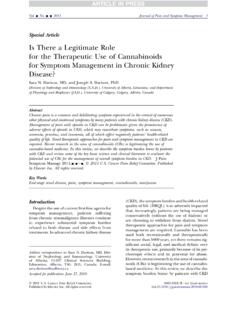Transcription of Endocannabinoids in Liver Disease
1 Endocannabinoids in Liver DiseaseJoseph Tam, Jie Liu, Bani Mukhopadhyay, Resat Cinar, Grzegorz Godlewski, and George KunosEndocannabinoids are lipid mediators of the same cannabinoid (CB) receptors that medi-ate the effects of marijuana. The endocannabinoid system (ECS) consists of CB receptors, Endocannabinoids , and the enzymes involved in their biosynthesis and degradation, and itis present in both brain and peripheral tissues, including the Liver . The hepatic ECS is acti-vated in various Liver diseases and contributes to the underlying pathologies.
2 In patientswith cirrhosis of various etiologies, the activation of vascular and cardiac CB1receptors bymacrophage-derived and platelet-derived Endocannabinoids contributes to the vasodilatedstate and cardiomyopathy, which can be reversed by CB1blockade. In mouse models ofliver fibrosis, the activation of CB1receptors on hepatic stellate cells is fibrogenic, and CB1blockade slows the progression of fibrosis. Fatty Liver induced by a high-fat diet or chronicalcohol feeding depends on the activation of peripheral receptors, including hepatic CB1receptors, which also contribute to insulin resistance and dyslipidemias.
3 Although thedocumented therapeutic potential of CB1blockade is limited by neuropsychiatric sideeffects, these may be mitigated by using novel, peripherally restricted CB1antagonists.(HE-PATOLOGY2011;53:346-3 55)Marijuana has been used for its psychoactiveand medicinal properties for millennia. Likeother plant-derived substances, marijuanahas been slow to yield its secrets, with insights into itsmechanism of action beginning to emerge only duringthe last decades. The existence of specific cannabinoid(CB) receptors in mammalian tissues was first revealedby radioligand binding, and this was followed by themolecular cloning of two G protein coupled are the most abundant recep-tors in the mammalian brain, but they are alsoexpressed in peripheral tissues, including various celltypes of the Liver , at much lower yet functionally rele-vant are expressed pri-marily in immune and hematopoietic cells and havealso been detected in the Liver in certain ,10 Additional CB receptors may exist.
4 11buttheir potential role in Liver biology is discovery of CB receptors triggered a search forendogenous ligands. Arachidonoyl ethanolamide(AEA), also known as anandamide, was the first suchligand discovered,12with 2-arachidonoyl glycerol (2-AG)identified 3 years ,14 Additional endogenousligands have since been identified1but have receivedless attention. AEA and 2-AG are generated on demandin response to a rise in intracellular calcium or metabo-tropic receptor biosynthesis frommembrane phospholipid precursors may proceed alongmultiple, parallel ,16 Once released, theyremain largely membrane-associated because of theirhydrophobic nature, and they can be taken up by cellsvia a high-affinity uptake mechanism17;thisisfollowedby their enzymatic degradation.
5 AEA is metabolized pri-marily by membrane-associated fatty acid amide hydro-lase (FAAH),18whereas 2-AG is preferentially degradedby monoglyceride psychoactive properties of CBs and the abun-dance of CB1receptors in the brain could suggest thatAbbreviations: 2-AG, 2-arachidonoyl glycerol; ACC, acetyl coenzyme Acarboxylase; AEA, arachidonoyl ethanolamide; AFLD, alcoholic fatty liverdisease; AM630, 6-iodo-2-methyl-1-[2-(4-morpholinyl)ethy l]-1H-indol-3-yl](4-methoxyphenyl)methan one; AM6545, 5-(4-(4-cyanobut-1-ynyl)phenyl)-1-(2,4-d ichlorophenyl)-4-methyl-N-(1,1-dioxo-thi omorpholino)-1H-pyrazole-3-carbox-amide; ApoE, apolipoprotein E; CB, cannabinoid; CBD, cannabidiol; CPT1,carnitine palmitoyltransferase 1; DIO, diet-induced obesity; ECS,endocannabinoid system; FA, fatty acid; FAAH, fatty acid amide hydrolase;HCC, hepatocellular carcinoma; HSC, hepatic stellate cell; HU-308, 4-[4-(1,1-dimethylheptyl)-2,6-dimethoxyp henyl]-6,6-dimethylbicyclo[ ]hept-2-ene-2metha-nol.
6 I/R, ischemia/reperfusion; JWH-133, (6aR,10aR)-3-(1,1-dimethylbutyl)-6a,7,10 ,10a-tetrahydro-6,6,9-trimethyl-6H-diben zo[b,d]pyran; LCB1 / ,livercannabinoid receptor 1 knockout; LPL, lipoprotein lipase; MTP, microsomaltriglyceride transfer protein; NAFLD, nonalcoholic fatty Liver Disease ; RAR, retinoidA receptor; SREBP1c, sterol regulatory element binding protein 1c; TG,triglyceride; THC, tetrahydrocannabinol; VLDL, very low density the National Institute on Alcohol Abuse and Alcoholism, NationalInstitutes of Health, Bethesda, August 2, 2010; accepted November 5, reprint requests to: George Kunos, , , National Instituteon Alcohol Abuse and Alcoholism, National Institutes of Health, 5625 FishersLane, MSC-9413, Bethesda, MD 20892-9413.
7 E-mail: by the American Association for the Study of Liver this article online at conflict of interest: Nothing to endocannabinoid system (ECS) is primarily a neu-ronal signaling system; therefore, evidence for the pres-ence and functional importance of the ECS in theliver2was unexpected. Indeed, early studies of brainCB1receptors used the Liver as a negative , recent reports have documented low-levelCB1expression in the whole Liver ,2-4,21-23hepato-cytes,6,23-25stell ate cells,5,26and hepatic vascular endothe-lial cells27-30(see Fig.)
8 1). CB1receptors are present inhuman hepatocytes25and in the whole human Liver ,with increased expression noted in patients with hepa-tocellular carcinoma (HCC)7or primary biliary are undetectable in the normal liverbut are induced in pathological conditions such asnonalcoholic fatty Liver Disease (NAFLD),31the em-bryonic state,32liver fibrosis,9the regenerating Liver ,33and Endocannabinoids levels are simi-lar to those in the brain,2,26whereas FAAH expressionis higher in the Liver versus the brain. Evidence impli-cating the ECS in the regulation of hepatic hemody-namics, fibrogenesis, and lipid metabolism and in thedysregulation of these functions in pathological statessuch as cirrhosis, NAFLD, alcoholic fatty Liver , and is-chemia/reperfusion (I/R) injury is discussed and AlteredHemodynamics in CirrhosisThe potent hypotensive action ofD9tetrahydrocan-nabinol (THC)
9 Has long been recognized, and attemptshave even been made to exploit it for the treatment and the similar effects of syntheticCB analogues and Endocannabinoids are mediatedby CB1receptors located, in part, in the peripheralcardiovascular system,35and they play a pathogenicrole in various forms of shock,36,37including Liver cirrhosis is associated with endotox-emia and hypotension, and this suggests endocannabi-noid involvement. Indeed, cirrhosis in rats is accompa-nied by progressive hypotension reversible by CB1blockade,27which also reduces the elevated portal ve-nous pressure and mesenteric blood flow.
10 The likelysource of Endocannabinoids is activated macrophages,in which lipopolysaccharide induces the CD14-depend-ent synthesis of ,41 AEA levels are elevated in cir-culating macrophages of cirrhotic rats or patients, andsuch macrophages injected into normal rats elicit CB1-mediated ,42 Cirrhosis increases CB1expression in vascular endothelial cells27or in mesen-teric arteries29,43and increases the vasodilator potencyof ,43,44In patients with cirrhosis, circulatingAEA levels, but not 2-AG levels, are increased in pe-ripheral blood but not in hepatic veins or Liver tissue,and this suggests that the Liver is not its findings implicate AEA as a mediator of thevasodilated state in cirrhosis.


